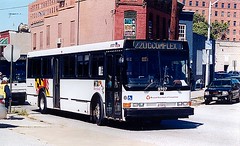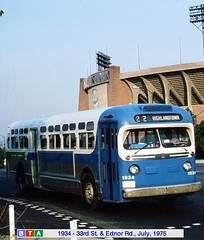One more thing about Baltimore Transit
 MTA bus 9707, Sep. 19, 2004 at Ostend & Scott Streets near Camden Yards, Route 220. NABINUT photo. From the Baltimore Transit website.
MTA bus 9707, Sep. 19, 2004 at Ostend & Scott Streets near Camden Yards, Route 220. NABINUT photo. From the Baltimore Transit website.In a separate e-conversation, it appears that some people think that the Dr. Transit roundup on Friday lauded the bus service in Baltimore. Actually, while I liked certain aspects of the marketing., I spent way too much time waiting for buses.
Frequency is key to making bus service successful, because unless you have no other choices you won't wait. So is shorter and faster point-to-point service-routing. AND, all bus systems should post schedules at each stop. With Adobe Acrobat and a good documents management system (something government agencies are good at), it is possible (a pain, but possible) to publish and post schedules at each bus stop. Maybe I just have the bad luck of arriving a minute after the bus... having the times listed gives the user more control.
In short, I think that the WMATA system provides much greater frequency, for less!--DC area bus fares are $1.35. MTA fares are $1.60--at least in the northern quadrants of the District of Columbia...
 Bus service at Memorial Stadium in 1975. From the Baltimore Transit website.
Bus service at Memorial Stadium in 1975. From the Baltimore Transit website.



0 Comments:
Post a Comment
<< Home